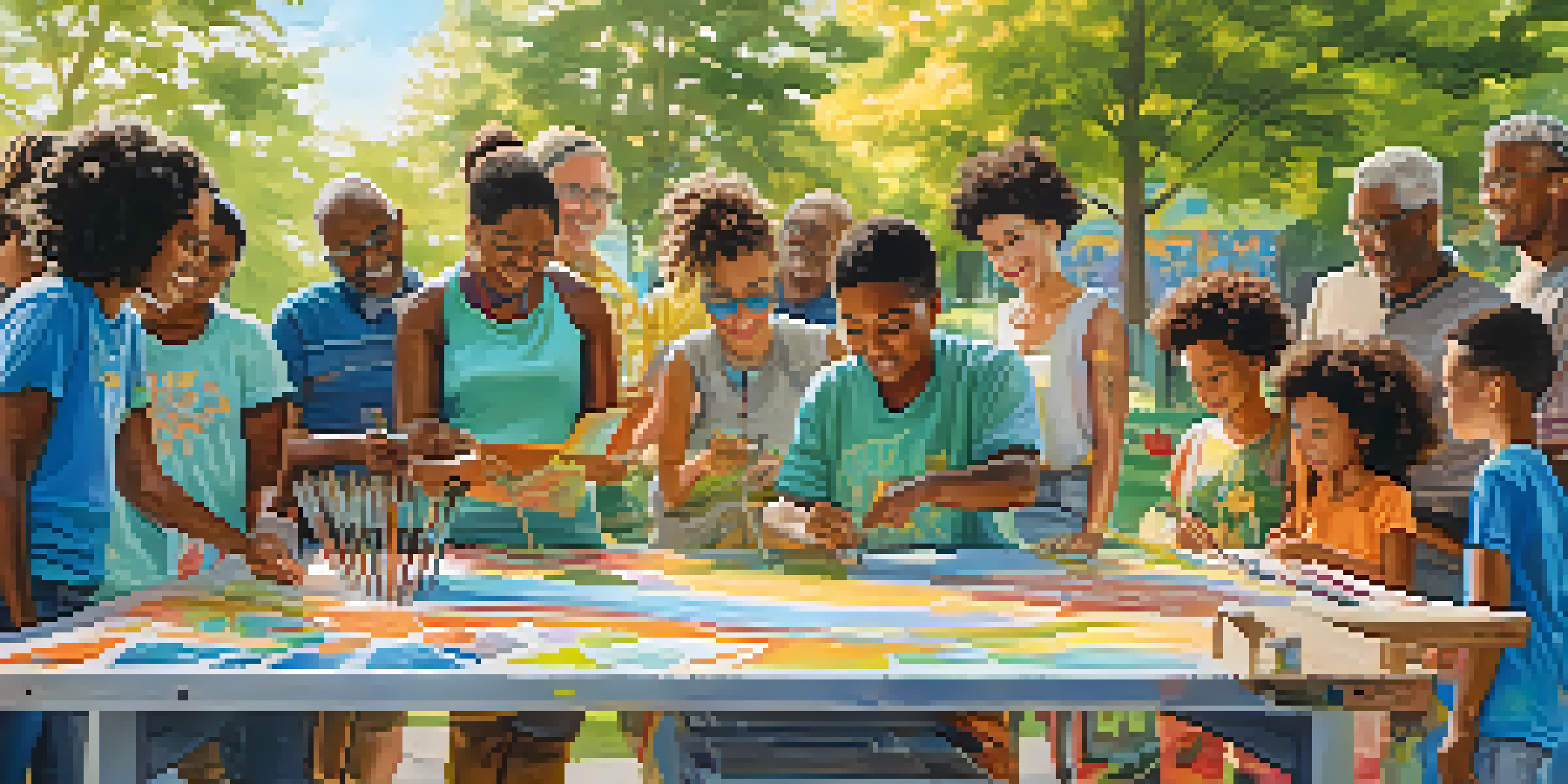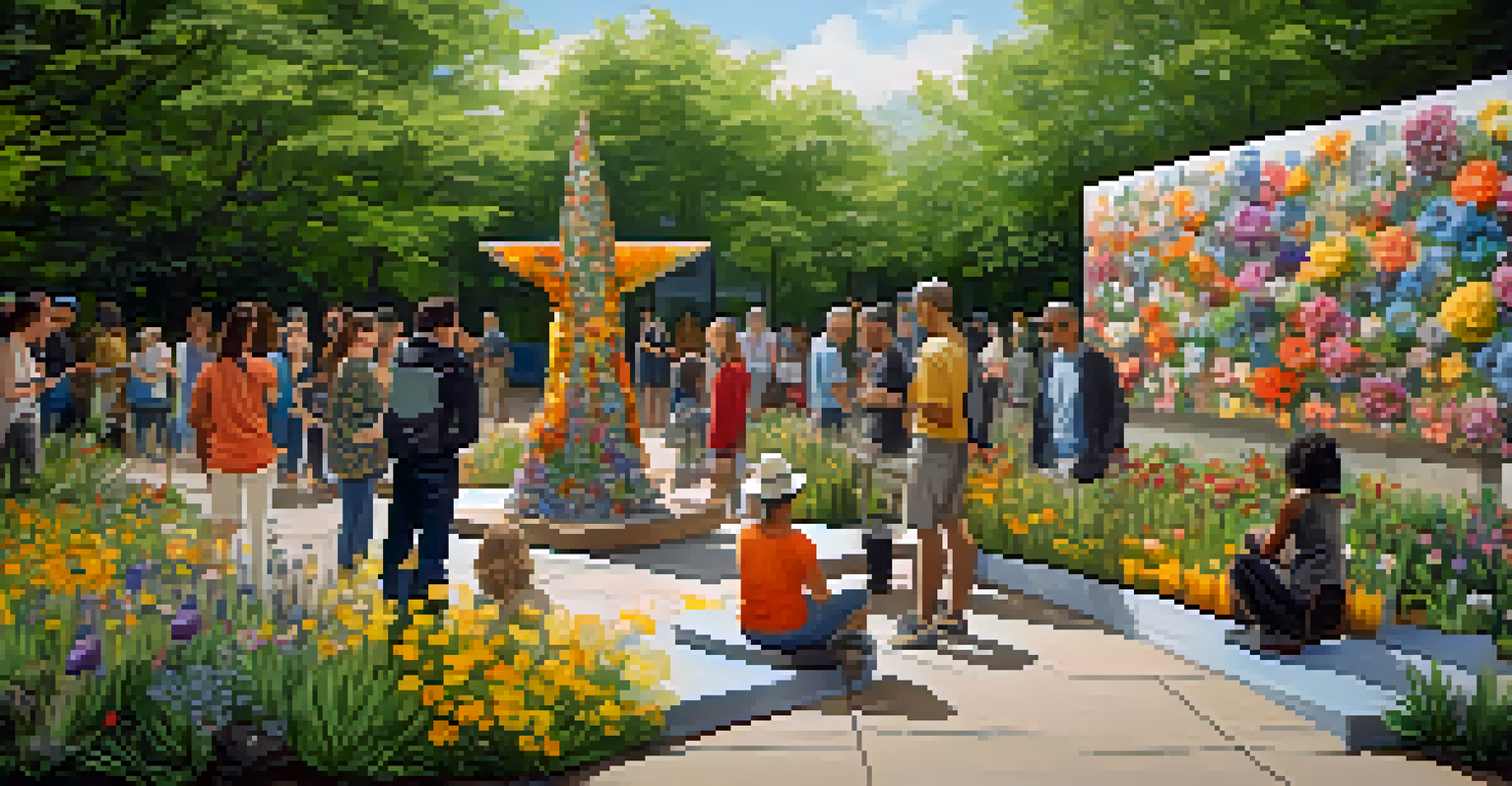Intersectionality in Art Accessibility Discussions

Understanding Intersectionality in Art Accessibility
Intersectionality is a term coined by scholar Kimberlé Crenshaw, referring to how various social identities overlap and affect individuals' experiences. In the context of art accessibility, it highlights how factors like race, gender, disability, and socioeconomic status can influence one's access to art. Recognizing these intersecting identities is crucial for creating more inclusive and accessible art environments.
Art is not a mirror held up to society, but a hammer with which to shape it.
For example, a person with a disability might face barriers to accessing an art gallery, while also dealing with the additional challenges of being a person of color. This complex web of identities can make it even more difficult to enjoy and engage with art. Therefore, understanding intersectionality allows artists and institutions to better cater to diverse audiences and create a more equitable art world.
By considering intersectionality, we can start to identify and dismantle the barriers that prevent marginalized communities from fully participating in the art scene. This approach encourages collaboration and learning from one another, ultimately enriching the art community as a whole.
The Role of Art Institutions in Promoting Accessibility
Art institutions play a pivotal role in promoting accessibility, yet they often overlook the diverse needs of their audiences. By applying an intersectional lens, these institutions can evaluate their policies, programs, and exhibitions to ensure they are inclusive. This might involve rethinking how art is displayed, how information is conveyed, and how audiences are invited to engage.

For instance, providing materials in multiple languages or offering sensory-friendly exhibitions can make a significant difference for various groups. Additionally, training staff on the importance of intersectionality can foster a more welcoming environment. Institutions that prioritize accessibility are more likely to attract a diverse audience and enhance community engagement.
Intersectionality Enhances Art Access
Understanding how various social identities overlap is crucial for creating inclusive and accessible art environments.
Ultimately, the responsibility lies with art institutions to actively work towards inclusivity. By embracing intersectionality, they can create spaces where everyone feels valued and represented, leading to a richer cultural dialogue.
Community Engagement and Intersectionality
Community engagement is vital for making art accessible, and intersectionality plays a key role in shaping these interactions. By understanding the unique identities and experiences of community members, artists and organizations can tailor their outreach efforts. This might include hosting workshops or events that specifically cater to underrepresented groups.
In a world where you can be anything, be kind.
For example, a community art project could focus on the stories of local immigrants, amplifying their voices and experiences through artistic expression. Such initiatives not only foster inclusion but also build a sense of belonging within the community. Engaging with diverse perspectives can lead to innovative ideas and collaborations that enrich the art landscape.
Moreover, when community members feel that their identities are acknowledged and celebrated, they are more likely to participate in art initiatives. This creates a feedback loop where artists and organizations continuously learn and adapt, ensuring that art remains relevant and accessible to all.
Art Accessibility: A Global Perspective
Art accessibility is not just a local issue; it has global implications that intertwine with intersectionality. Different cultures and societies have unique challenges regarding access to art, influenced by their social structures and histories. Understanding these global perspectives can help us appreciate the diverse ways in which art can be made accessible.
For instance, in some countries, economic barriers may prevent entire communities from engaging with art, while in others, cultural norms might limit who is allowed to participate. By looking at art accessibility through an intersectional lens, we can identify common challenges and share solutions across borders. This collaboration can lead to innovative approaches that consider the nuances of each community.
Art Institutions Must Embrace Inclusion
Art institutions play a vital role in promoting accessibility by reevaluating their policies and practices through an intersectional lens.
Ultimately, addressing art accessibility on a global scale requires a commitment to understanding and respecting diverse identities. By fostering international dialogues, we can work together to create a more inclusive art world that transcends boundaries.
The Impact of Technology on Art Accessibility
Technology has revolutionized how we access and experience art, providing new opportunities for increased accessibility. Online platforms, virtual galleries, and digital exhibitions can reach audiences who may not be able to visit physical locations. However, it's crucial to consider how technology intersects with different identities to ensure that everyone can benefit from these advancements.
For example, while online exhibitions can be a boon for individuals with mobility issues, they may still be inaccessible to those with limited internet access or digital literacy. Therefore, it is essential to create hybrid models that cater to various needs. Integrating technology with traditional art forms can foster more inclusive experiences.
As we move forward, it’s important to continue examining the intersectionality of technology and art accessibility. By addressing these complexities, we can harness the power of technology to make art more available to all, especially those from marginalized communities.
Art as a Tool for Social Change
Art has long been a powerful medium for social change, and when combined with intersectionality, its impact can be profound. Artists often use their work to address social issues, challenge norms, and raise awareness about marginalized voices. By exploring the intersections of identity in their art, they can foster deeper connections with audiences and inspire action.
For instance, murals that depict the struggles of various communities can serve as a visual representation of their experiences. These artworks not only beautify public spaces but also spark conversations that challenge societal norms. When diverse stories are told through art, they can create a ripple effect that encourages empathy and understanding.
Technology Can Widen Art Accessibility
While technology offers new ways to experience art, it is essential to ensure that these advancements address the diverse needs of all audiences.
Ultimately, art becomes a catalyst for social change when it recognizes and amplifies the voices of those who have been historically silenced. By embracing intersectionality, artists can contribute to a more equitable society, where everyone's story is valued and celebrated.
Future Directions for Art Accessibility
Looking ahead, the future of art accessibility will undoubtedly be shaped by the principles of intersectionality. As more artists, institutions, and communities recognize the importance of inclusivity, we can expect to see innovative approaches to making art accessible. This may include developing new policies, programs, and technologies that prioritize diverse perspectives.
Additionally, ongoing conversations about intersectionality will continue to inform the strategies employed by the art world. By actively seeking input from marginalized voices, the art community can ensure that accessibility efforts are relevant and effective. This collaborative approach will foster a more inclusive environment for everyone.

In conclusion, the future of art accessibility lies in our ability to embrace intersectionality. By recognizing and addressing the unique needs of diverse communities, we can create an art world that is truly accessible, inviting, and representative of all.